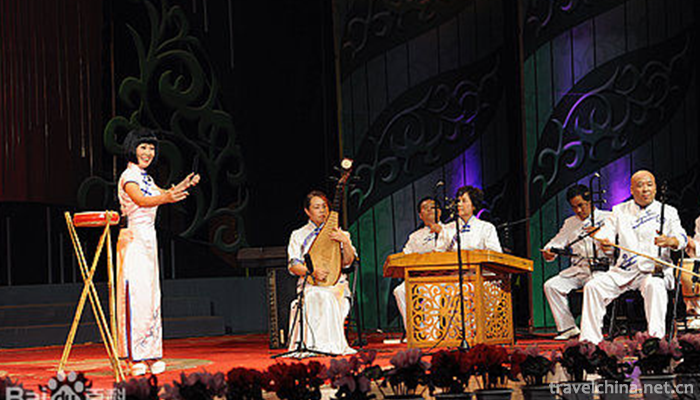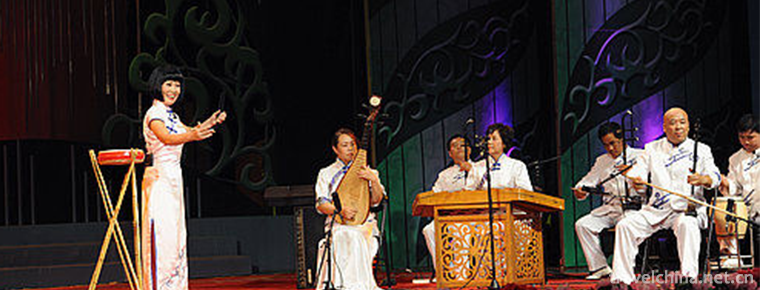Sanxianshu
Sanxianshu
Sanxianshu, also known as Qianzi Shu and Leg Blackboard Shu, is an ancient traditional rap art formed in Nanyang, Henan Province. It has a history of more than 250 years. It is named for its main accompaniment instrument, which is composed of three strings and Qianzi (small cymbal). It is one of the four major local songs. For the first time, it was a play for one person, with three strings in one's arms and legs (feet) playing and singing by oneself. Later, with the improvement of audiences'aesthetic requirements and the development of nature, Nanyang gradually evolved into a two-or-three-person opera with singers hitting hinges or octagonal drums to sing and watch, accompanied by three strings and falling Hu to help tune and interrupt in singing, which enabled the rap art to develop faster and spread more widely. Nanyang is the "hometown of opera art" named by the Chinese Opera Artists Association. Yangqu art is famous all over the country. The main types of Nanyang Quyi are major tunes and three-string books. Sanxianshu has important value and influence.
On June 7, 2008, Sanxianshu was approved by the State Council and listed in the second batch of national intangible cultural heritage list.
Introduction to Sanxian Books
Sanxianshu's singing style is simple and unadorned, lively in form, rich in local flavor, deeply loved by the people. It is a typical traditional rap art. It once ruled Nanyang opera circle, and has been passed on for more than 100 years. There are more than 400 songs in existence, including more than 200 passages, more than 100 book caps and 36 medium-length books. Their literary and musical artistic level is very high.
Tri-genre Style
The Three Emperors'Club
After the mid-Qing Dynasty, Sanxianshu was relatively prosperous. It mainly adopted the method of setting up "imperial society", also known as Huishu (equivalent to the present form of performance), namely "Sanhuangshu".
Sanxian calligraphers worship the three emperors (Mikado, Dihuang, Renhuang) as their ancestors. On the birthday of the three emperors, artists gather, set up shelters, burn incense to worship God and sing for three days. The conference is organized by old artists and invitations are sent to all "teams" and artists.
Invited persons should pay certain gifts to the Royal Society as expenditure funds. According to the level of artists, the imperial club will perform in "head shed", "two shed" and "three shed". It also employs famous artists and talent, as well as famous local gentry, to appraise the repertoire of the performances. These people also have division of labor. They have the purpose of specializing in music, singing music (including accompaniment), lyric and song combination and performance. They are called "social management", "editorial", "voice calling", "word listening" and so on. Being rated first class by the conference is equivalent to winning the "top prize" and giving awards, called "hanging red", the artists who hang red enjoy high honor in society and among artists. If the performance is not good, there will be penalties for different words, wrong words, off-board, barren tune and other situations. If you find that the lyrics are too elegant or crude, you will receive severe corrections.
Rules and regulations
In addition to artistic exchanges and mutual improvement among artists, the "Three Emperors'Club" also has the nature of close association.
In the county of Sanxianshu, a person in charge should be elected as "Tour 1000", and rules and regulations should be formulated to manage the performance discipline and style of artists. The Royal Council's statutes include: no sharp selling, no picking on other people's tea and meals, no abducting other "team" fellows, no abducting apprentices, no stealing other people's things, no turning back and forth of lies, etc. If a woman is found to be abducted, she shall cut her eyes and ears at the Royal assembly and be forbidden to perform in three-stringed books; if someone steals someone else, she shall be dismissed by the Royal Society by word of mouth, and her colleagues have met with the stringers; and if the disciples are abducted, they will beat five hundred willow sticks, etc. The "Three Emperors'Club" also requires three kinds of stability, i.e. eye stability, hand stability and mouth stability: eye stability means not looking at women in performance and life; hand stability means not taking other people's things; mouth stability means not speaking low-level obscene language. If offenders break strings and burn burdens. The regulations of the Three Royal Societies are very strict, which regulates the performance criteria of artists, corrects their moral character and promotes the development of the art of Sanxianshu. This rule continued until the eve of liberation.
Schools
As an art category, Sanxianshu has evolved into different genres in terms of performance techniques, use of tunes and singing characteristics due to the different dialects and folk customs, along with the deepening of understanding of tune, board road, mode and tonality in the long-term singing.
From 1930s to 1930s, Sanxianshu, which mainly distributes in the southwest of Henan Province, formed three major schools: the East Road School, the Middle Road School and the West Road School, each of which has its own singing style. Taking the Jinglou of Credit Banner Town, Mobi, Rao Liang, Tanghe River and the Anpeng area of Tongbai as the Eastern Road School, its representative figures are Zhang Yongxi, Anyusong, Wu Kaishan, etc. They are mainly high-chord singers with high-spirited style, strong momentum, and are good at Wushu and Zhengshu, with the beauty of masculinity. The Qiaotou in the west of Credit Banner is the central road school, and its representative figures are Liu Yongke, Wang Simazi and Kingdom. Dong et al. are mainly plain chord singers with soft and deep style, good at expressing feelings, and have three wonderful chants; Shiqiao and Fangcheng in Nanyang are the West Road School, whose representatives are Liu Literature, Lei Shengtang, Pei Xuede, Zhang Mingchuan, etc. They are mainly bass singers, whose style is solemn and delicate, melancholy and lingering. After a song, the remaining tones surround the beam.
Characteristic
The three schools have their own characteristics. However, due to the influence of geographical environment, language and sister songs, the Donglu School has a distinct difference from the Zhongxi Road, which has the charm of Hubei Yugu and Henan Southern Folk Songs. In a word, the formation and development of the three schools are the result of absorbing the folk songs, ballads and dialects from different regions, so they are more local and popular with the masses on one side.


-
1.Chess cake
Chess cake is a special product of Tangshan District in Hebei Province. It is named for its shape like a small drum and a chess piece
Time 2018-11-27 -
2.Huangguoshu Waterfalls Scenic Area
Huangguoshu Scenic Spot is a key national scenic spot, located in southwest Guizhou Province, 128 kilometers away from Guiyang City, the capital of Guizhou Province
Time 2018-12-12 -
3.Jiuhuangshan Ape King Cave Scenic Area
Jiuhuangshan Ape King Cave Scenic Area, located in Beichuan Qiang Autonomous County of Mianyang, Sichuan Province, is the largest karst cave in southwest China and a famous tourist cave in Western Chi
Time 2018-12-22 -
4.Shenyang Forest Wildlife Park
Shenyang Forest Zoo is a state-level forest wildlife park approved by the State Forestry Administration and the Ministry of Construction. Located in the Chebanshan International Scenic Tourism Develop
Time 2019-02-08 -
5.Mashan folk songs
Mashan Folk Song is a traditional folk song form which is popular in the area of Mashan Town, Jingzhou District, Jingzhou City, Hubei Province. One of China's national intangible cultural heritage lis
Time 2019-05-15 -
6.Siping Tune
The Siping tune evolved from the flower drum in eastern Henan. After digging and sorting out, it absorbed the tunes of opera critics, Peking Opera, Henan Opera and so on. It gradually perfected and fo
Time 2019-06-16 -
7.Yongxiu Yaya Opera
Yongxiu Ya Opera originated in Wu Town, one of the four famous towns in Jiangxi Province. It was born in the late Ming Dynasty and Ganbei Bench Opera. Because all of its female characters were played
Time 2019-07-14 -
8.Chengdu Sport University
Chengdu Institute of Physical Education is one of the six institutes directly under the former State General Administration of Sports. It is now a co-established Institute in Sichuan Province with the
Time 2019-08-31 -
9.Anhui University Of Technology
Anhui University of Technology is located in Anhui province. Ma'anshan The city is a multi-disciplinary university characterized by industry and industry. Ministry of science and technology With the s
Time 2019-10-10 -
10.China Agricultural University
China Agricultural University (China Agricultural University), referred to as "China Agricultural University", is located in Beijing City By Ministry of Education of the People's Republic of
Time 2019-12-21 -
11.History of Deyang
In ancient times, it was a place of hundred PU. In the fifth year of King Shenliang of Zhou Dynasty (316 BC), that is, in the ninth year of gengyuan, King Huiwen of Qin Dynasty, Qin destroyed the two states of Bashu and established two prefectures of Bashu. Today, Deyang Prefecture belongs to Shu Prefecture. County under the county, County Pavilion.
Time 2020-12-14 -
12.Nanchong science and technology
In 2019, Nanchong implemented 97 key science and technology plan projects, an increase of 7.8% over that in 2018, including 83 national and provincial science and technology plan projects. It won 11 provincial science and technology progress awards. In the whole year
Time 2020-12-17